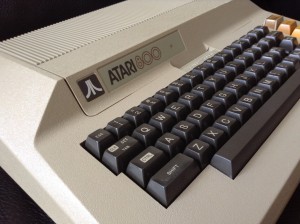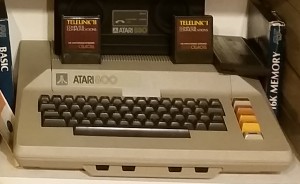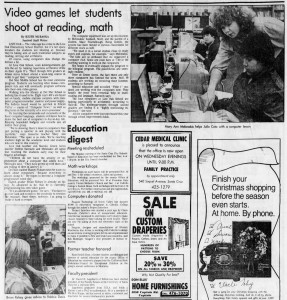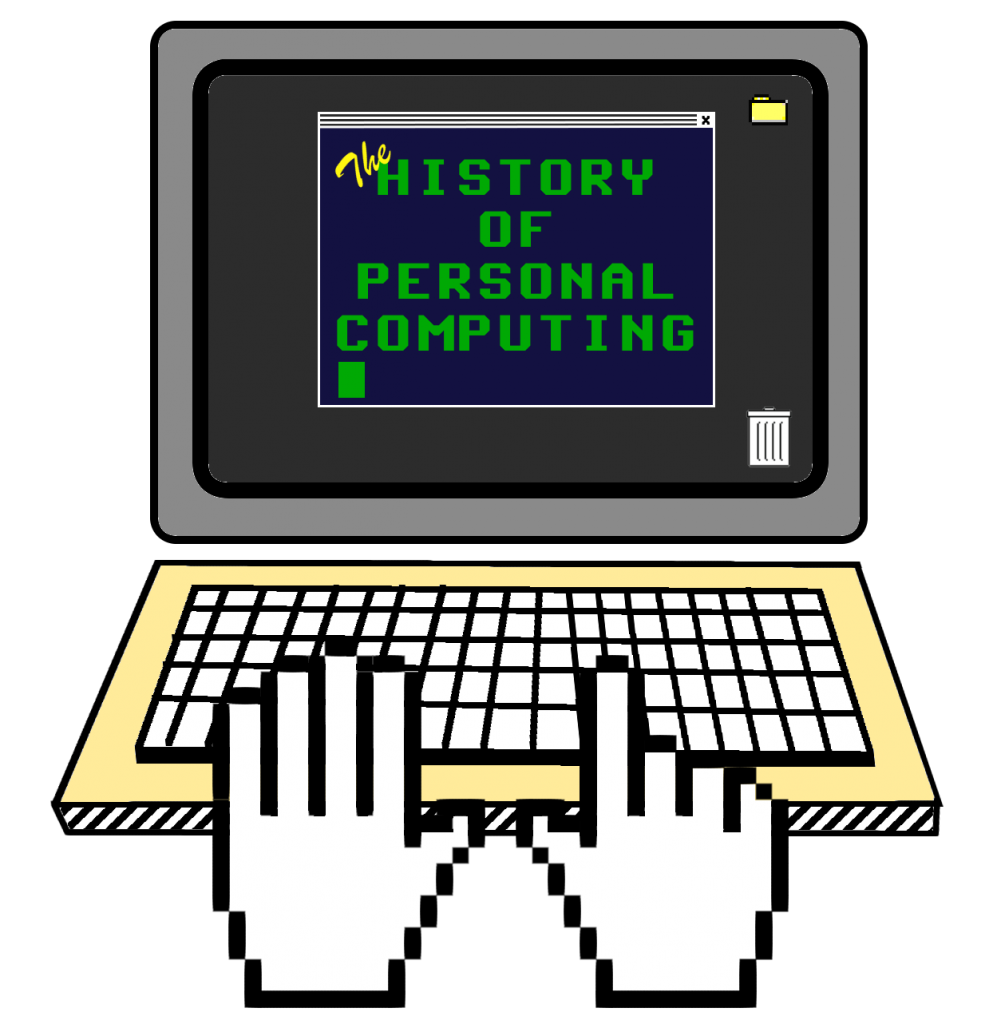Atari 400 and 800
Atari began development of the 400 & 800 in 1977, using the code names Candy (400) and Colleen (800). Rumor has it that these names came from some “hot” secretaries there at Atari. Candy was originally intended to be the next generation of the video game system, to replace the VCS. Colleen was intended to be the true home computer with all the bells and whistles that would make it superior as a computer to Candy, including peripheral ports and expansion capability. Some people may not know that there was actually a third machine being designed at the same time called ‘Elizabeth,’ which was the Colleen design but with a built- in 13 inch color monitor.
| Listen to our podcast episode about the Atari 400 and 800 computer here |
In early 1979 the decision on just what Candy is going to be was finally made: Candy was not going to be a ‘game player only’ machine, but was to be a low- end computer system with a built-in keyboard. However, since it is intended to be more of an introductory computer for younger children, it includes a unique keyboard design with a spill proof membrane. Candy will also have an SIO port for peripherals.
Since the game player system design had been moved to a personal computer, it was no longer a replacement for the VCS, which was to keep Atari’s consumer gaming products well ahead of the competition. With that, the first step towards the demise of Atari’s domination in the console market had been taken.
Discussing the unique, small- wedged shape design of the Atari 400, and its keyboard, Doug continues: “Candy was meant to be a laptop computer. This is before LCD displays and such. What I mean is, it was designed to be able to sit in your lap, but connected to a TV. It was a game console, but could use the same cartridges as the other system and it had a keyboard I also designed the spill proof membrane keyboard.”
Kevin McKinsey explains the whole background behind the look of the Atari 800: “I wanted something that would look like a futuristic typewriter. A design that was easily recognizable and approachable by ordinary people who already knew what typewriters were.”
the USB and SIO ports have a lot more in common than anyone might imagine: Joe Decuir helped with some of the work on the SIO design and today Joe holds several Patents in the design of the USB port as well. Essentially, the SIO port is the Great Grandfather to today’s USB ports.
System specs
- Both systems use a 1.79 MHz 6502 CPU, along with various co-processors (a rather novel feature for a home computer) that share various computing tasks such as graphics, sprite collision, and sound.
- The 400 comes with 8K RAM, 16K for newer models; The 800 has 8K, expandable to 48K
- Both systems possess
- 10K ROM
- 40×25 text display, along with various bitmapped graphic modes up to 320×192
- 128 color palette
- Four sound voices spanning a 3.5 octave range
- The 400 has a 61 key membrane keyboard. The 800 has a standard style 61 key full stroke keyboard.
- Although they both supported a video output for an NTSC color composite monitor, they also were able to connect directly to a TV antenna input. This was one of the first “out of the box” computers to do so.
- The 400 had a single cartridge slot, usually used for game cartridges or for a BASIC cartridge. The 800 had two cartridge slots, called “left cartridge” and “right cartridge” respectively. The right cartridge slot was intended to support any left side cartridges, but very few right side cartridges were made.
- Behind the 800’s cartridge slots, there were memory expansion slots which used specially designed cartridges to increase the maximum RAM.
The Company
In 1966, Nolan Bushnell saw the early computer game of Spacewar! being played at the University of Utah. He thought that there was a definite potential for a commercial coin-op version, so he partnered with Ted Dabney several years later to work on a hand-wired version which would play on a standard black and white television. The final product was called Computer Space and was released in 1971 by the coin-op game company Nutting Associates. The game was not a success in their standard markets, taverns, so the team looked to create an easier game, and they started their own company, Atari in 1972.
Atari hired Al Alcorn as their first design engineer, and when Bushnell saw a demonstration of the Magnavox Odyssey game console, he decided to have Alcorn produce an arcade version of the Odyssey’s tennis game. This product would go on to become Pong and eventually Magnavox sued Atari and won. Atari had to pay them a licensing fee after that. Many people believe that Atari invented “Pong,” but this was of course not so, plus, the Magnavox Odyssey came to market three years before Atari’s Pong game console.
Atari’s Pong console did well and was upgraded a number of times, then in October 1977, the company released the Atari 2600 or VCS (for Video Computer System) and it became the most successful gaming console of its time. Also noteworthy is that Jack Tramiel stormed out of a January 13, 1984 meeting of Commodore’s board of directors, and never returned to the company. Later, in July of 1984, he purchased the Consumer Division of Atari, Inc. from Warner Communications. He renamed it Atari Corporation, and went on to produce the 16-bit Atari ST line of personal computers. We’ll discuss the 2600, ST and much more in later episodes.
The Legacy
ASAP (Atari Software Acquisition Program) – Perhaps one of the earliest attempts by a computer manufacturer to tap the general public for useful and productive software.
Geared more toward software genres other than games, Atari promoted contests and offered software publishing opportunities under the Atari Program Exchange (APX) moniker for anyone from professional software writers to simply even the most savvy armchair developer. Atari was looking for more business, educational, and personal finance applications to augment their library of software that was on the verge of being completely overrun with games.
Not that games weren’t a good way to exploit the capabilities of the early Atari line of computers, but having a substantial productivity software selection lends professional credence to something that would have been otherwise considered to be a glorified video game machine.
Emulation
- Windows
- Altirra – http://www.virtualdub.org/altirra.html
- XFormer – http://www.emulators.com/xformer.htm
- Atari800Win Plus – https://atariage.com/5200/emulation/atari800_tutorial/
- Mac
- Atari800MacX – http://www.atarimac.com/
- Raspberry Pi
- Atari800 – Atari800 is an Atari 800, 800XL, 130XE and 5200 emulator for Unix, Amiga, MS-DOS, Atari TT/Falcon, SDL and WinCE – http://store.raspberrypi.com/projects/atari800
- There are also emulators that will run on iOS and Android. Check your system’s app store for details.
Interesting History about the Atari 400/800
| Back in October 1982, the Harris’ department store in San Bernardino, CA, gave away an Atari 400 with the purchase of a 32 piece Towle sterling silver dinnerware set. Retail price of the dinnerware sets started at $1299. |
|
|
| Also in 1982, the Live Oak Elementary School in Santa Cruz, CA was doing something that was somewhat unusual. While other schools having computers in their classrooms were typically stocked with Apple or TRS-80 computers, a slowly growing trend at the time, Live Oak had eight Atari 400 computers set up in the school library for student use. Of course… these computers were for “learning purposes only!” |
|
|
| The Atari 400 was offered as an option for a specialized robot called DC-2, or Drink Caddy 2, created by the Robot Factory in 1982. We’re not sure if the Atari actually performed any function in the robot other than to give people something to do when the robot came around to them at parties. |







January, 8th 2016 at 12:51 am
Just a few notes about your discussion:
– Atari DID end up using the 400/800 technology for their next-generation game system – the 5200. The 5200 was essentially a keyboardless 400 with bad joysticks. 😉
Don’t ask me how I know this (heh), but many of the games that came out for the 5200 were pirated and modified for use on the computer line. Most of the modifications dealt with making the control mechanisms compatible between the two systems. Games like Vanguard or Gremlins were never officially released on the computer systems… Officially. But, due to the digital controls on the computer, they were certainly more playable there. 😉
– The 400 actually had 2 expansion slots inside the metal RF shielding – one was a CPU board, the other was a 16K memory board – BUT – it was not as easy to simply take out the 16K board and plug in a 48K expansion.
Once you got all the screws out of the thing, you had to modify 4 solder points on the mainboard before you could slip in a 3rd party expansion. Why all the hassle? Well…
– When the 400/800 machines were developed, Atari was making the same mistake that Radio Shack, and later, T.I. made. They wanted to control the hardware AND software markets by limiting and not documenting the hardware. Their thinking was that they and they alone could change the specifications of the 400, if they needed to, and corner the software market for their creations – just like with the VCS.
Today, we know how wrong-headed that was, but back then, it made some kind of sense. Atari quickly shifted gears a few years later when they realized that a good software selection was critical to a computer’s success, and finally commissioned documentation on the machines (De Re Atari).
Radio Shack purposely disabled the ability to run CP/M on the Model I and III lines – although technically, both Z-80 based machines could have easily done so.
But at least the Atari, being one of many 6502-based computers, could be reverse engineered to some degree. With T.I., all of their hardware was custom designed, and even Peek and Pokes were limited to very strict memory address boundaries. T.I. didn’t learn this lesson until lack of software forced them out of the computer market altogether.
– I believe the original intention of the Right Hand Cartridge slot was to add features to something running on the Left hand side. Remember, this is before bank selecting in a single cartridge was a ‘thing’. In the end, there was little or no development for it, especially since the 400 outsold the 800 3:1.
– The often unsung hero of the VCS, the 400/800 computers, and later, the Amiga, was Atari engineer Jay Miner. While almost everyone else in the industry embraced the idea of frame buffers (which were memory intensive), and character-based graphics (which had it’s plus and minuses); Jay’s idea of building a screen line by line allowed a great deal of flexibility.
On the VCS, the entire display was built line by line by the CPU – out of necessity. That necessity being cost, as the VCS was initially designed as a machine that could play ‘really great’ Pong-type games. In 1977, not even Jay Miner could conceive of the VCS running something like Pitfall, Ms. Pac Man, Yar’s Revenge, or Space Invaders.
On the 400/800 and Amiga, you could have a display that not only added separate resolutions, but also color palettes on a scanline by scanline basis. Take a look at a 400/800 game like ‘Koronis Rift’ by Lucasfilm Games: Over 100 colors and mixed resolutions – all on one screen. Or behold the Hold And Modify (HAM) modes on the Amiga that displayed 4096 colors at once. Amazing!
Miner’s understanding of pre-HD television and how to cleverly manipulate it, had no equal during those early days. The fact that a machine built in 1977 could still be relevant through the early 80’s is a testament to his skill and ingenuity. Take THAT Woz! 😉
– One of the biggest controversies in Atari computers had to do with the 1983 introduction of the 1200XL. The 64K 1200XL used a new ROM that mapped things like the ‘Help’ key, self-diagnostics, an international character set, SIO ‘plug and play’, and fixed a few BASIC flaws. However, this shifted memory locations around.
A number of games that previously worked on the 400/800, all of a sudden stopped working on the 1200XL.
Atari, in it’s defense, had tried to warn developers that using memory spaces close to or reusing the code IN the ROM areas was a big ‘no-no’, but apparently not everyone got the message (this WAS pre-Internet, after all), or simply ignored it. Either way, developers were VERY pissed off.
As a result, a few dropped Atari software development over the fracas.
– Question: What was the ‘killer app’ that sold more Atari computers than anything else? Star Raiders. Star Raiders was the first killer game for a computer. It stayed on the charts in ‘Computer Games’ magazine until they folded in 1984. When you saw this thing (especially like when I did in 1980!), you just couldn’t believe what you were seeing – it was that far ahead of it’s time. A real-time space/strategy game, complete with different screens, and true 3D gameplay. That was a marvel!
– The BASIC programming language, like most interpretive languages of their time was slow, and all but useless for serious development. The only good thing I can say about it is that at least (unlike some certain computers that begin with C=), you didn’t have to Peek and Poke through memory just to plot graphics or play sound. There were actually commands for that sort of thing. 😉
My friend had ‘Macro Assembler’, but it was so obtuse – and without a floppy drive (I initially had a cassette), was all but useless.
Later, a company called OSS developed a language called, ‘Action!’, and it truly awakened the programmer in me. I tested a program I had written to generate randomized mountains, and Action! could fill the screen in seconds while Atari Basic was still drawing the initial part of the math.
I found an article on anti-aliasing in Byte Magazine with an accompanying pseudo-code example of how to make it work, and I remember Atari BASIC could take a Mode 9 picture and convert it in a minute and a half. My Action! version? 7 SECONDS…
As a side note, my assembler friend was so impressed with the code that he asked to borrow the article. He had purchased a 6 MHz ‘Mindset’ PC, and re-wrote the code in assembler. His code was able to draw a full 640X350 16 color picture and anti-alias it in 550 microseconds… Show off! :O
Of course with today’s GPU’s, you can do 8X AA at hundreds of frames per second… Ah, Progress.